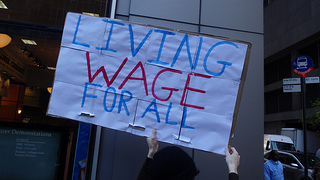Why Do Some Jobs Pay So Little?
A recent one-day strike by fast-food workers has called attention to the low wages in the industry. James Surowiecki offers one reason that the issue’s visibility has increased recently:
Still, the reason this has become a big political issue is not that the jobs have changed; it’s that the people doing the jobs have. Historically, low-wage work tended to be done either by the young or by women looking for part-time jobs to supplement family income. As the historian Bethany Moreton has shown, Walmart in its early days sought explicitly to hire underemployed married women. Fast-food workforces, meanwhile, were dominated by teen-agers. Now, though, plenty of family breadwinners are stuck in these jobs. That’s because, over the past three decades, the U.S. economy has done a poor job of creating good middle-class jobs; five of the six fastest-growing job categories today pay less than the median wage. That’s why, as a recent study by the economists John Schmitt and Janelle Jones has shown, low-wage workers are older and better educated than ever. More important, more of them are relying on their paychecks not for pin money or to pay for Friday-night dates but, rather, to support families. Forty years ago, there was no expectation that fast-food or discount-retail jobs would provide a living wage, because these were not jobs that, in the main, adult heads of household did. Today, low-wage workers provide forty-six per cent of their family’s income. It is that change which is driving the demand for higher pay.
Given that reality, Surowiecki writes, raising the minimum wage by a few bucks a hour won’t fix the problem. His prescription: more truly middle-class jobs and an expansion of the social safety net. “Fast-food jobs in Germany and the Netherlands,” he writes, “aren’t much better-paid than in the U.S., but a stronger safety net makes workers much better off.”


Comments